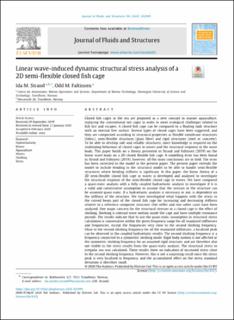| dc.contributor.author | Strand, Ida Marlen | |
| dc.contributor.author | Faltinsen, Odd Magnus | |
| dc.date.accessioned | 2021-02-09T10:52:31Z | |
| dc.date.available | 2021-02-09T10:52:31Z | |
| dc.date.created | 2020-02-26T09:55:55Z | |
| dc.date.issued | 2020 | |
| dc.identifier.issn | 0889-9746 | |
| dc.identifier.uri | https://hdl.handle.net/11250/2726862 | |
| dc.description.abstract | Closed fish cages in the sea are proposed as a new concept in marine aquaculture, replacing the conventional net cages in order to meet ecological challenges related to fish lice and escapes. A closed fish cage can be compared to a floating tank structure with an internal free surface. Several types of closed cages have been suggested, and they are categorised according to structural properties as flexible membrane structures (fabric), semi-flexible structures (glass fibre) and rigid structures (steel or concrete). To be able to develop safe and reliable structures, more knowledge is required on the seakeeping behaviour of closed cages in waves and the structural response to the wave loads. This paper builds on a theory presented in Strand and Faltinsen (2019) on the linear wave loads on a 2D closed flexible fish cage. A modelling error has been found in Strand and Faltinsen (2019), however, all the main conclusions are in hold. The error has been corrected in the model in the present paper. The present paper extends the model to include bending in the structural model to be able to handle semi-flexible structures where bending stiffness is significant. In this paper, the linear theory of a 2D semi-flexible closed fish cage in waves is developed and analysed to investigate the structural response of the semi-flexible closed cage in waves. We have compared a quasi-static analysis with a fully coupled hydroelastic analysis to investigate if it is a valid and conservative assumption to assume that the stresses in the structure can be assumed quasi-static. If a hydroelastic analysis is necessary or not, is dependent on the stiffness of the structure. We have investigated what happens with the stress in the curved beam part of the closed fish cage for increasing and decreasing stiffness relative to a reference composite structure. One stiffer and two softer cases have been analysed. One major concern for the structural stresses in a closed cage is the effect of sloshing. Sloshing is internal wave motion inside the cage and have multiple resonance periods. The results indicate that to use the quasi-static assumption in structural stress calculation is conservative within the given frequency range for all examined stiffnesses and frequencies, except the frequencies very close to the second sloshing frequency. Close to the second sloshing frequency for all the examined stiffnesses, a localised peak can be observed in the coupled hydroelastic results. The second sloshing frequency is a frequency connected to a symmetric sloshing mode. Rigid body motion is not affected at the symmetric sloshing frequency for an assumed rigid structure, and are therefore also not visible in the stress results from the quasi-static analysis. The structural stress in irregular sea was calculated. These results show no indication of increased stress close to the second sloshing frequency. However, this is not a surprising result since the stress peak is very localised in frequency, and the accumulated effect on the stress standard deviation is therefore small. | en_US |
| dc.language.iso | eng | en_US |
| dc.publisher | Elsevier | en_US |
| dc.rights | Navngivelse 4.0 Internasjonal | * |
| dc.rights.uri | http://creativecommons.org/licenses/by/4.0/deed.no | * |
| dc.title | Linear wave-induced dynamic structural stress analysis of a 2D semi-flexible closed fish cage | en_US |
| dc.type | Peer reviewed | en_US |
| dc.type | Journal article | en_US |
| dc.description.version | publishedVersion | en_US |
| dc.source.volume | 94 | en_US |
| dc.source.journal | Journal of Fluids and Structures | en_US |
| dc.identifier.doi | 10.1016/j.jfluidstructs.2020.102909 | |
| dc.identifier.cristin | 1797645 | |
| dc.relation.project | Norges forskningsråd: 268402 | en_US |
| dc.description.localcode | /© 2020 The Authors. Published by Elsevier Ltd. This is an open access article under the CC BY license (http://creativecommons.org/ licenses/by/4.0/). | en_US |
| cristin.ispublished | true | |
| cristin.fulltext | original | |
| cristin.qualitycode | 1 | |

